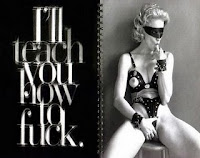image source
Historic homes, industrial buildings transformed into live or work spaces, fireplace surrounds... In fact, brick walls are often highly sought-after architectural features. image source
But sometimes, brick can be overbearing, dirty-looking, or just not the "look" you are going for. image source
People are often torn: do they leave the brick as is? Do they paint it a light color in an attempt at camouflage? Or do they cover it up entirely with wood, stone or tile?Here's a thought I hadn't considered before: what about simply Coloring them? Not a flat coat of latex interior paint, mind you. (not to say that this can't be a beautiful solution, too) But what about embracing the textural variation in tone, overlaid with beautiful rich color? Intrigued? I was.
I had never seen this approach attempted until I discovered photos of a particular apartment in the Chelsea Hotel. The space is rented (not even owned!) by Gerald Decock, an artist and hairstylist with a unique perspective on color in interiors.
image source
When Gerald moved into his Chelsea space, everything was pure white. “I am obsessed with color in its most vivid state,”(source), and so set to work transforming the entire apartment. images source with permission from Todd Selby
His apartment is Wild! As one article puts it so eloquently, "the whole vibe is reminiscent of a harlequin outfit put into a blender without the lid."(source)But what caught my eye was his extraordinary treatment of brick in his apartment.
image source
One brick wall is completely covered in gold leaf. Evidently, it took him an entire month to cover the brick, as gold leaf is most easily applied to smooth surfaces, not bumpy, lumpy brick. image source with permission from Todd Selby
Another brick wall was a variety of violets. Gorgeous. The translucent pigments allow the natural variations in the brick to show through so that the walls don't appear flat or too uniform. Instead, they practically vibrate with life.image source
To replicate this look without necessarily delving into fuchsias and violets, brick staining/tinting kits are available. Instead of coating everything one tone, I would opt for several similar color choices, then mix different strengths of the stain to mimic the different shades in the brick. Much more natural looking.
Wait, we can't leave our tour of Gerald's apartment without a parting glance at...wait for it...his hot pink ceiling!
image source
Gerald's enthusiastically painted ceiling brings the rest of his crazy colors and decorations together. The icing on the cake, I'd say. 
image source
"Everything was kinda done, and the ceiling was white, and it was really bothering me", says Gerald, "Once the ceiling was complete, which I painted, like, a hot pink fluorescent color I felt like the apartment was like, more whole." (source) image source with permission from Todd Selby
Oh yes, and the floors are orange. Of course.Okay, so does that spark some ideas for how you'll deal with tired old brick in your house? Anyone ready to paint their ceiling pink? Oh come on, give it a try- it's only paint!




























